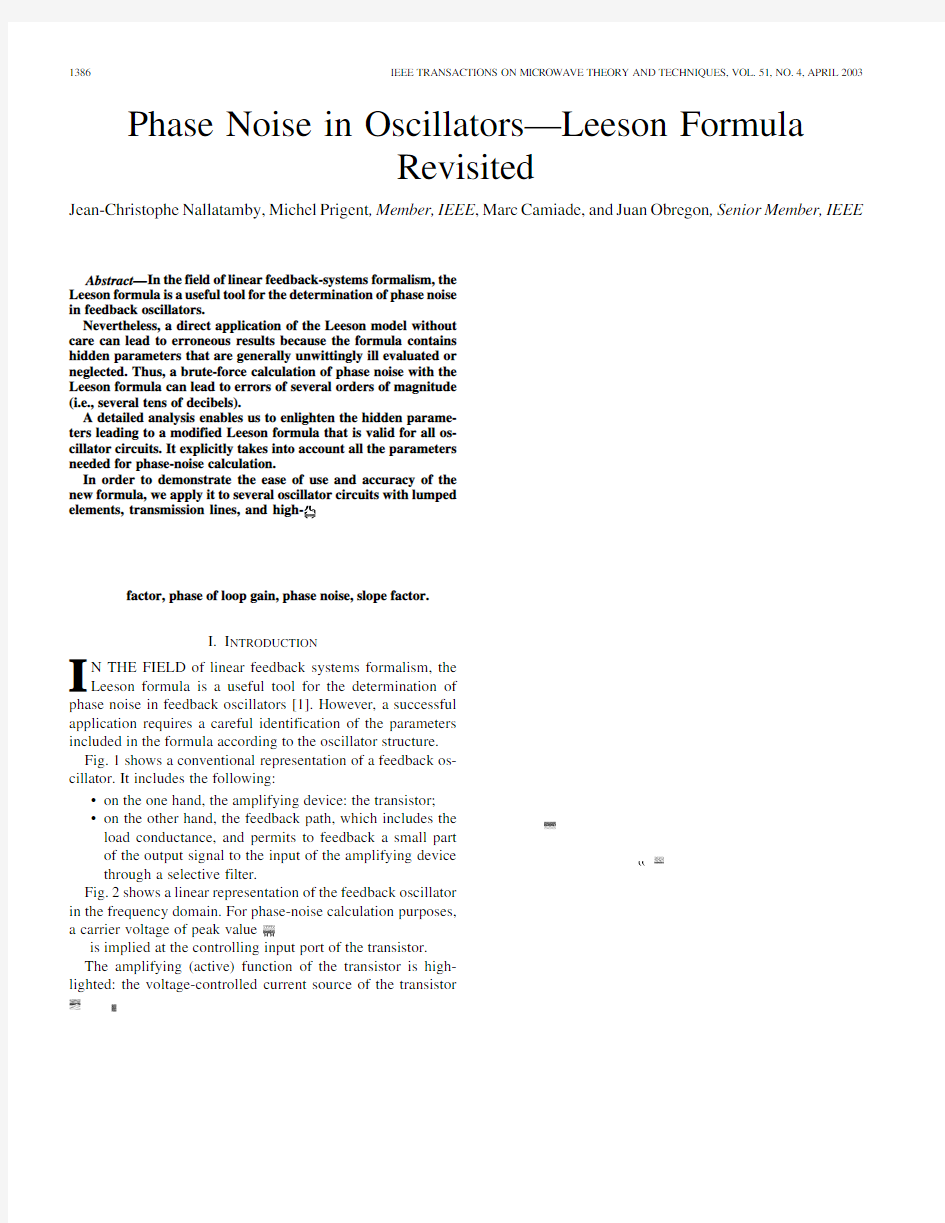

Phase Noise in Oscillators—Leeson Formula
Revisited
Jean-Christophe Nallatamby,Michel Prigent,Member,IEEE,Marc Camiade,and Juan Obregon,Senior Member,IEEE Abstract—In the field of linear feedback-systems formalism,the
Leeson formula is a useful tool for the determination of phase noise
in feedback oscillators.
Nevertheless,a direct application of the Leeson model without
care can lead to erroneous results because the formula contains
hidden parameters that are generally unwittingly ill evaluated or
neglected.Thus,a brute-force calculation of phase noise with the
Leeson formula can lead to errors of several orders of magnitude
(i.e.,several tens of decibels).
A detailed analysis enables us to enlighten the hidden parame-
ters leading to a modified Leeson formula that is valid for all os-
cillator circuits.It explicitly takes into account all the parameters
needed for phase-noise calculation.
In order to demonstrate the ease of use and accuracy of the
new formula,we apply it to several oscillator circuits with lumped
elements,transmission lines,and high-
factor,phase of loop gain,phase noise,slope factor.
I.I NTRODUCTION
I N THE FIELD of linear feedback systems formalism,the
Leeson formula is a useful tool for the determination of
phase noise in feedback oscillators[1].However,a successful
application requires a careful identification of the parameters
included in the formula according to the oscillator structure.
Fig.1shows a conventional representation of a feedback os-
cillator.It includes the following:
?on the one hand,the amplifying device:the transistor;
?on the other hand,the feedback path,which includes the
load conductance,and permits to feedback a small part
of the output signal to the input of the amplifying device
through a selective filter.
Fig.2shows a linear representation of the feedback oscillator
in the frequency domain.For phase-noise calculation purposes,
a carrier voltage of peak value
is implied at the controlling input port of the transistor.
The amplifying(active)function of the transistor is high-
lighted:the voltage-controlled current source of the transistor
(a)
(b)
Fig.3.(a)[Y ]representation of the feedback circuit.(b)[C ]chain-matrix representation of the feedback circuit.
One noise source alone is not always sufficient to characterize a noisy transistor.
However,in the most general case,two correlated
sources
and are
sufficient.
becomes
matrix does not exist for all the pas-sive circuits so the chain matrix (also called
the
(2)
with
,
where are the chain-matrix coefficients taken
at
Let us look at two narrow-band (1Hz)uncorrelated compo-
nents
.
A classical treatment [6],[7]shows that by addition to a pure
carrier signal of peak
value
,these un-correlated components give rise to a modulated carrier with a phase-noise spectral
density
and opening the feedback loop,Fig.5(b)is obtained.We
have
and
(9)
where denotes the complex voltage gain in the frequency do-
main.
1In the technical literature,the phase noise (5)or (6)is called the “phase noise
spectral density.”Nevertheless,physically and dimensionally it is a power ratio as is demonstrated below.From (1),=
S j
I :j C
j
L LAT
Fig.6.Normalized closed-loop representation of a feedback oscillator for phase noise calculations.
A straightforward calculation gives
successively
(15)
becomes
and
(28)
and near the carrier
frequency
Fig.8.Feedback oscillator with a transmission-line coupled resonator.
Equation (29)clearly shows that,by
increasing
generally reduces to the input capac-itance of the transistor alone.The
ratio
is then in-versely proportional to the transistor area and,accordingly,the output phase noise is also inversely proportional to the transistor area.
It must be noted that (29)can be easily evaluated by designers.If we now write
the
and
factor”
coincides with the
loaded
different from the
loaded
and electrical
length
factor of the oscillator (without simultaneously varying the res-onant frequency or,to the first order,the
loaded
factor
Now,without loss of accuracy,the energy stored in the coupling line may be practically neglected as compared to that of the resonator,the
loaded
factor of the oscillator
becomes
(32)
so
that
Fig.9.Schematic of the transmission-line coupled resonator oscillator used for numerical simulations.
Fig.10.Output phase-noise spectral density versus the electrical length
When oscillation conditions are satisfied,we
have
factor
.
Noting
that
factor of the di-
electric resonator was3000and the oscillation frequency was
10
GHz.
Fig.12.Output phase-noise spectral density versus the electrical length
(45)
with
,i.e.,
can be obtained from(6)and(47)as follows:
is independent of
,.
IX.C ONCLUSION
A detailed analysis of the output phase noise of feedback os-cillators has been performed.The results have been compared to the Leeson formula.The hidden parameters included in the for-mula have been set off and highlighted in(19)and(20),leading to a new formulation better suited to design purposes.
The expression of the loaded
Marc Camiade was born in France,in1958.He re-
ceived the Dpl.Eng.degree in physics and electronic
engineering from the Institut National des Sciences
Appliquées,Toulouse,France,in1981.
In1982,he joined Thomson-CSF as a Design
Engineer of hybrid circuits,during which time
he participated in a variety of microwave and
millimeter-wave circuits.Since1988,he has been
an Application Group Manager in charge of new
product development based on microwave integrated
circuit(MIC)and MMIC components.In1996,he joined United Monolithic Semiconductors,Orsay,France,where he is currently in charge of the development of components for defense and automotive applications.He is also currently and mainly involved in all the functions for radar front-ends from L-to W
-bands.
Juan Obregon(SM’91)received the E.E.degree
from the Conservatoire National des Arts et Métiers
(CNAM),Paris,France,in1967,and the Ph.D.
degree from the Universite de Limoges,Brive,
France,in1980.
He then joined the Radar Division,Thomson-CSF,
where he contributed to the development of para-
metric amplifiers for radar front-ends.He then joined
RTC Laboratories,where he performed experimental
and theoretical research on Gunn oscillators.In
1970,he joined the DMH Division,Thomson-CSF, and became a Research Team Manager.In1981,he was appointed Professor at the Universite de Limoges.He is currently Professor Emeritus with the Universite de Limoges.Since1981,he has been a consultant to microwave industrial laboratories.His fields of interest are the modeling,analysis,and optimization of nonlinear microwave circuits,including noise analysis.